'Persona 4: Dancing All Night' Review: Despite Absurd Premise, Quirky Anime Dance Game Just Works

Atlus, makers and publishers of the RPG series colloquially known as “Persona,” have made some offbeat games in their day. The Persona franchise itself is well-known and loved for its humor and irreverence, even while presenting serious psychological issues. The last main series game, “Persona 4: Golden,” encapsulated all this and is honestly the best Japanese RPG I’ve played since "Final Fantasy X." So when Atlus announced a story-driven/rhythm game spinoff entitled “Persona 4: Dancing All Night,” I’d like to say I wasn’t terribly surprised. But I was. Even for Altus, this was just ridiculous. Somehow, it works. Mostly.
The basic premise of "Persona 4: Dancing All Night" is that the old crew is back, one year after the events of Golden to participate in a music festival as a team of backup dancers. A few days before the festival begins, one of the other performing acts (the idol group called “Kanamin Kitchen”) vanishes to a supernatural realm. Our young heroes pursue them, just as they saved others from similar fates one year earlier. But there’s no violence or fighting allowed in this dark realm -- they must push their way through enemies by getting their dance on. Seriously. The characters you’re used to seeing beat up Shadows with blades, pistols, and chairs are now soothing enemies with rhythm and dance.

Now that we’ve accepted that the premise is absurd, let’s get to the story. The source material and characters are fabulous, so even a spinoff like this should be solid -- but it’s hard to not be a bit disappointed with the writing. The story’s linearity isn’t so much an issue as its presentation; the script’s idea is pretty solid, but the delivery comes across as watered down. It feels as though the writers were shackled by the “Teen” rating -- Persona games typically run with “Mature” ratings. Witty jokes, hilarious character growth and interactions, mature introspective themes and irreverent charm -- Dancing All Night doesn’t have these, eschewing an adult delivery for something much more lighthearted. It’s like a pretty typical teenager-friendly anime, talking about expressing feelings and touching hearts, but only in the lightest way. There’s no expression of soul or deep introspection, though the script does try this at times (sort of unsuccessfully).
It’s just an overall tone of “Let’s do our best together,” which is just about the most eyeroll-inducing anime trope out there. It’s nothing seasoned JRPG/anime fans haven’t seen before, and it definitely doesn’t carry the weight or humor that Golden established.
None of that really matters once you finish the story though, because any rhythm game has to bank on gameplay, first and foremost. What "Dancing All Night" presents is a curious six button input system framed by a pair of semicircles. At first, it’s a bit confusing (coming from traditionalist interfaces like "Dance Dance Revolution" or swinging momentum setups like "Project Diva"), but after a few hours of practice it was easy to pull off complicated maneuvers like holding buttons on opposing sides of the screen. The game builds its difficulty and introduces new hurdles subtly though, so you always feel like the learning curve isn’t too unfair. Generally if there’s a new element or pattern thrown in, you’ll see it a few times before the song is over, so even if you don’t pass the first time, you have a good idea what to expect on your next attempt.
How you’re doing (and how much the Shadows are feeling your performance) is represented by a “rhythm gauge.” In practice, it’s a little graphic of five rabbits that changes colors from red to rainbow, but it’s not as quantitative as a digital bar. It does sort of makes sense, given the dancing context though. It takes a lot of perfect moves strung together (100+ on harder levels) to make a dent if you’ve missed notes, but when you’re feeling it, the game’s feeling it too so you won’t get thrown off by a slight misstep. Three or four in a row will get you in trouble though, until you build things back up...sort of like a real dance routine. Higher difficulty levels are strict, but fair; there’s no limping through tough routines.

“Hard” will pose some challenge, but not for long. You’ll want to unlock the “secret” difficulty level above it, the eponymous “All Night” level. The tracks throw more notes and more difficult patterns challenging your brain with difficult weird combinations, and your eyes with flashing lights. Here the game gets in its own way; the main note color is yellow, but yellow is also heavily used in the game’s backgrounds so notes will often blend in, making things more a test of color determination than rhythm. But when you get it right, you’ll finish routines with a silly smile on your face. Though seeing the characters’ dances has a lot to do with that.
There’s something really enjoyable about seeing all your favorite characters in a different setting like this. They’ve all got their own distinct styles too, from protagonist Yu’s smooth disco-infused moves to Yosuke’s b-boy breaks and Chie’s martial arts-infused kicks, so it always feel like they’re bringing some unique elements to the tracks they’re on. Even little Nanako gets in on the action, (she’s basically the cutest thing ever).

The soundtrack certainly has its moments, but even including DLC songs you’re looking at a relatively small library (30 or so tracks), many of which are remixes and variations of four or five songs. Variety isn’t the soundtrack’s strongest suit; "Persona 4: Dancing All Night" does have good genre diversity (funk, a little hopstep, techno, house) but it would really benefit from a few more unique songs. To be fair, the game’s source material played only a handful of tracks over a 70 hour adventure, so it’s not like there was much to draw from anyway. What is there is skewed towards dancy/upbeat tracks for obvious reasons.
While storytelling isn’t "Persona 4: Dancing All Night’s" strong point, the smiles its gameplay grants more than make up for it. If you own a Playstation Vita and liked "Persona 4: Golden," this is worth playing. If you like rhythm games on top of all that, this is absolutely worth your attention. Just don't expect perfection.
Persona 4: Dancing All Night was reviewed using a press copy provided by Atlus. The game releases in Western markets on September 29th, 2015.
© Copyright IBTimes 2024. All rights reserved.





















